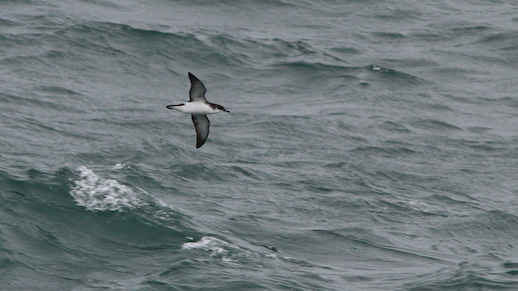Words: Jon Gower
Ynys Enlli, Bardsey Island, off the northwestern arm of north Wales, is home to a substantial population of Manx shearwaters, members of the petrel family, which look for all the world like little albatrosses. Specifically they’re tubenoses, which refer to the tube like structures that cover the nostrils. These birds are the very epitome of flight, able to fly through the tunnel formed as a wave turns in on itself.
Of all the world’s eleven thousand or so bird species this an absolute favourite of mine. No, it’s more than that. This is my animal familiar. Just as, say the witches in Macbeth had cats as their familiars so this perfect seabird, is mine. A totemic animal, with all grace in its flight.
Its flying ability, its aeronautic aptitude is a joy to behold. As its name implies, it shears the waves, barely flapping its wings, needed the merest hint of breeze to sally forth over the brine. Sheer mastery of an element. There is a tale told about a bird that managed to fly through the tunnel at the heart of an enormous wave. This might well be just oceanic hyperbole, but watching them, as they wheel and turn over the sea, one can easily believe in such aerobatic feats. They turn as if on sparkling if invisible sixpences, winking among the wave crests. They bank, then angle their bodies the opposite way, white underbelly turning and resolving into slaty upperparts, flying, flickering, shearing, making light of gravity.
The Enlli Manxie can cover enormous distances. The birds that spend the summer, the nesting season, on and around the island traverse the whole of the Southern Atlantic to overwinter off the coast of Uruguay, Brazil and Argentina.
After a day out at sea, they bring back food for their young, settling in chattering flocks on the sea’s surface, waiting for nightfall. These congregations, called rafts are reminders that while we often imagine seabirds as they are when seen on land their true habitat, their real element, is the sea and most pelagic, or oceanic species become vulnerable on land. Watch guillemots in early spring, flying back and fore to their nesting ledges – neurotic, twitchy, impossibly unsettled – to see how land is a place fraught with danger, full of marauding gulls, and, in the worst case scenario, land-based mammals, most fearfully rats. Which adore seabird eggs and chicks. Gulped down raw.
If a shearwater in the air is an animal which seems to pretty much own the very air, to subjugate breeze and sea-breath to its own devices, on land it’s quite another matter. They nest underground, like puffins. Indeed Manx Shearwaters used to be called Manks Puffins back in the 17th century. Puffin is an Anglo-Norman word – the Middle English is pophyn – and was used to describe the cured carcasses of nestling shearwaters. The puffin itself acquired the name much later, possibly because of its similar nesting habits.
Land is so perilous for the shearwater. Ungainly, able only to shuffle only most inelegantly, the bird’s legs are set too far back on the body and to say it waddles is too kind. But it’s not just a matter of elegance. If a bird returning to its nesting burrow – often a hole previously inhabited by a puffin or a rabbit – doesn’t disappear pretty damn quick then marauding gulls will snaffle it up. On moonlit nights, in particular, ravenous great or lesser black-backed gulls stand sentinel at the mouths of burrows, waiting for the seabird equivalent to a pizza delivery. They’re snaffled up quickly, and pretty much devoured: in the morning all that will be left will be the indigestible wings and a sternum stripped completely clean of meat.
But the arriving birds, burdened with their oily gifts of sardines, sprat and squid do not arrive quietly. The colony is a cacophony , as the birds, whirling in, announce late supper and their very presence with an astonishing, gurgling, some might say blood-curdling cry. The local name for them in Pembrokeshire is cocklolly, the sound of gulps in the throat, and that local onomatopoeia isn’t far wide of the mark. R. M. Lockley, the doyen of Welsh naturalists, caught that eeriness, that macabre tone to their night-time cries in his lovely monograph about them when he said they sounded like ‘The sound of a rooster in full cry, seconds after his throat has been cut.’ Veritably a blood gargling sound.
